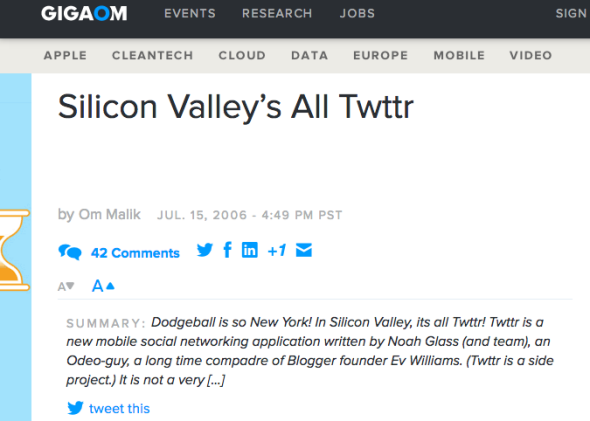The tech blogger Om Malik is, in my experience, an incisive commentator and a thoughtful writer. He has built his blog, GigaOm, into a thriving media company with a stable of sharp and thoughtful reporters. Which is part of why it’s so amusing to revisit his terrible first blog post about Twitter—then Twttr—from July 2006, just four months after it was founded.
More than that, though, the post—which may have been the first press about Twttr on any notable tech blog—is a reminder that once in a while even the most inane, frivolous-sounding startup ideas can end up changing the world.
At the time, Twttr was a side project of Odeo, a San Francisco podcasting startup run by Noah Glass and Ev Williams. As Nick Bilton chronicles in his new book Hatching Twitter, it grew out of a conversation between Glass and Odeo employee Jack Dorsey, a shiftless NYU dropout and shoe-company reject. Malik’s first post mentions the idea’s origins, and it accurately spells its name and identifies the key players. Other than that, in hindsight, it gets just about everything about the concept wrong. And it does it with a profusion of grammatical errors and exclamation points. The irrational exuberance begins with the lede:
Dodgeball is so New York! In Silicon Valley, its all Twttr!
“Dodgeball,” a few people might recall, was a precursor to Foursquare that allowed people to text their location and receive notifications of friends and “crushes” nearby. Twttr was derided by one commenter on Malik’s post as “Dodgeball-lite,” because it left out the find-your-crush part. But Malik’s post didn’t even go so far as to compare the two services’ pros and cons. It described Twttr thusly:
Twttr has married Short Code Messaging, SMS with a way to create social groups. By sending a text message to a short code (for TWTTR) you can send your location information, your mood information or whatever and share it with people who are on your social-mob! Best part – no installation necessary!
That sounds… awful. And indeed, Malik acknowledged that the service could be “annoying:”
The annoying SMS messages from nocturnal friends is not the only thing which bothers me about this service, but also the fact, that the texting a message(reply) to twttr ends up on their website. Best thing is to allow users to create micro groups, and give users the options of picking topics and setting rules to maintain privacy and control over the service. If Glass can do that, well, it be pretty awesome.
To summarize: Malik thought the one thing that could save Twitter would be to ditch the website and shepherd users into private “micro groups” where they could shoot “your mood information or whatever” to people who are “on your social-mob.” Nevertheless, he noted that the service seemed to be catching on even without those privacy features. “It’s spreading like a virus,” he declared, “and it is very viral.”
In Malik’s defense, the comments on his post make it clear he wasn’t the only one who misdiagnosed the potential pros and cons of Twttr. Hell, Twitter’s founders themselves didn’t really know what they had until months or even years later. As one commenter pointed out:
I don’t get why there is all this incest love among certain people. The Odeo folks are perfect examples They spend all their time at “in” parties. Do random stuff ’cause it is cool. They haven’t done anything with their core product, while more scrappy and focused players like http://www.zapzap.com and http://www.pluggd.com close the gap on them.
Click those links and you’ll see just how far being “scrappy” and “focused” got those startups.
It’s easy—and often valid—to criticize Silicon Valley startups for screwing around and building random services that they and their friends find amusing but that serve no obvious purpose for the world at large. But Twitter—which will go public this this week at a valuation of about $14 billion—is a classic example of how a foolish side project can grow bigger and more influential than any sane person could have predicted—let alone a tech blogger who had just gotten home from a night of drinking scotch and sucking on stogies with its founders.
Malik, by the way, has a far more reflective post about Twitter today, which draws heavily on the benefit of hindsight and is well worth a read for anyone interested in the microblogging service’s past and future. In it, he links to that first 2006 post and calls it “a lesson in humility; a reminder that no one knows what the future holds.”
